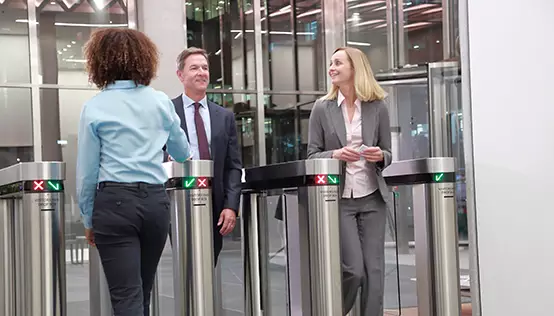



Unlocking the Power of Access Control
By charlotteb | 1st September 2023
Access control lies at the junction where security meets efficiency. As the business landscape continues to evolve post-COVID lockdown, organisations in all industries are benefitting from the use of comprehensive access control systems. Whether simple key cards or biometric scanners, these not only enhance security, but streamline daily operations.
By implementing access control strategies, businesses can better safeguard their people, property and assets. From restricting unauthorised access in sensitive areas (essential in highly regulated environments) to managing employee permissions and tracking visitor activity, access control takes security to a whole new level. It not only protects valuable resources but minimises the risk of data breaches and supports industry compliance.
In this blog we will explore the power of access control and how it enhances security while simplifying everyday operations; can it really revolutionise the way a business operates?
Five benefits of access control systems
Reduced reaction times: First and foremost, access control systems provide real-time monitoring and alerts, allowing businesses to detect and respond to security breaches promptly. For example, if an unauthorised individual attempts to gain access to a restricted area, the system can trigger an alarm or send an alert to security personnel, enabling them to take immediate action.
Furthermore, the technology can integrate with other security systems, such as surveillance cameras and alarm systems, creating a comprehensive, fast-response, security ecosystem. Integration allows seamless coordination between different security components, enhancing the overall effectiveness of the security infrastructure.
Convenience: Access control is not only used to enhance security; it also offers business convenience. With modern systems, employees can quickly gain access without a physical key. As we know, physical keys can be easily lost or stolen, so removing them gives organisations a more secure and traceable way to grant entry. If a key card or access token is lost, it can be quickly deactivated, rendering it useless. Plus, one key card or token can be used to access multiple areas, simplifying the process, and improving efficiency. Systems can also integrate seamlessly with other workplace solutions, such as time and attendance systems, further streamlining operational processes.
Access restriction: The ability to restrict access to sensitive areas is one of the biggest benefits of access control; with the right solution in place, only authorised individuals will be able to access specified locations. This is particularly important when managing server rooms, laboratories, executive offices or anywhere that confidentiality and the protection of assets are paramount.
Tied to the above, but with wider implications, access control offers the ability to manage employee permissions. Organisations can use software to assign different levels of access based on an employee’s role and responsibilities. This not only enhances overall security but simplifies the process of granting and revoking access privileges when people join or leave the business.
Tracking: It’s not just staff that access control systems can be used to track. They enable businesses to keep a record of all visitor activity, maintaining a digital stamp of anyone entering and exiting a premises. This not only helps in ensuring the safety of everyone onsite, but also provides valuable data for security audits and investigations. Should there be a fire, it can be used to confirm all heads are accounted for. In the event of a security breach, the data gathered via the system can provide crucial information about anyone involved, helping businesses take appropriate action.
Efficiency savings: One of the great things about the use of access control systems is how they can be integrated with other workplace solutions, such as the attendance technologies mentioned already. This brings huge savings in ‘time spent’ by automatically recording employee entry and exit times. It eliminates the need for manual attendance tracking and reduces the chances of errors or discrepancies in record-keeping.
The theme of streamlining is seen again in its the ability to generate detailed reports and analytics. Businesses can gain insights into employee movements, foot traffic, and overall access patterns. This information can be valuable for resource planning, identifying bottlenecks, and optimising workflows.
As technology continues to advance, access control systems are becoming increasingly sophisticated and powerful. The future holds exciting possibilities, including advancements in biometric authentication, cloud-based access control, and integration with emerging technologies including artificial intelligence and the Internet of Things (IoT).
So, can it revolutionise the way a business operates?
Absolutely.
By unlocking the power of access control, businesses can enhance security, streamline operations, and create a safer and more efficient work environment. Whether it’s protecting valuable assets, managing employee permissions, or simplifying everyday operations, access control systems offer a robust solution that can revolutionise the way businesses operate in the digital age.


